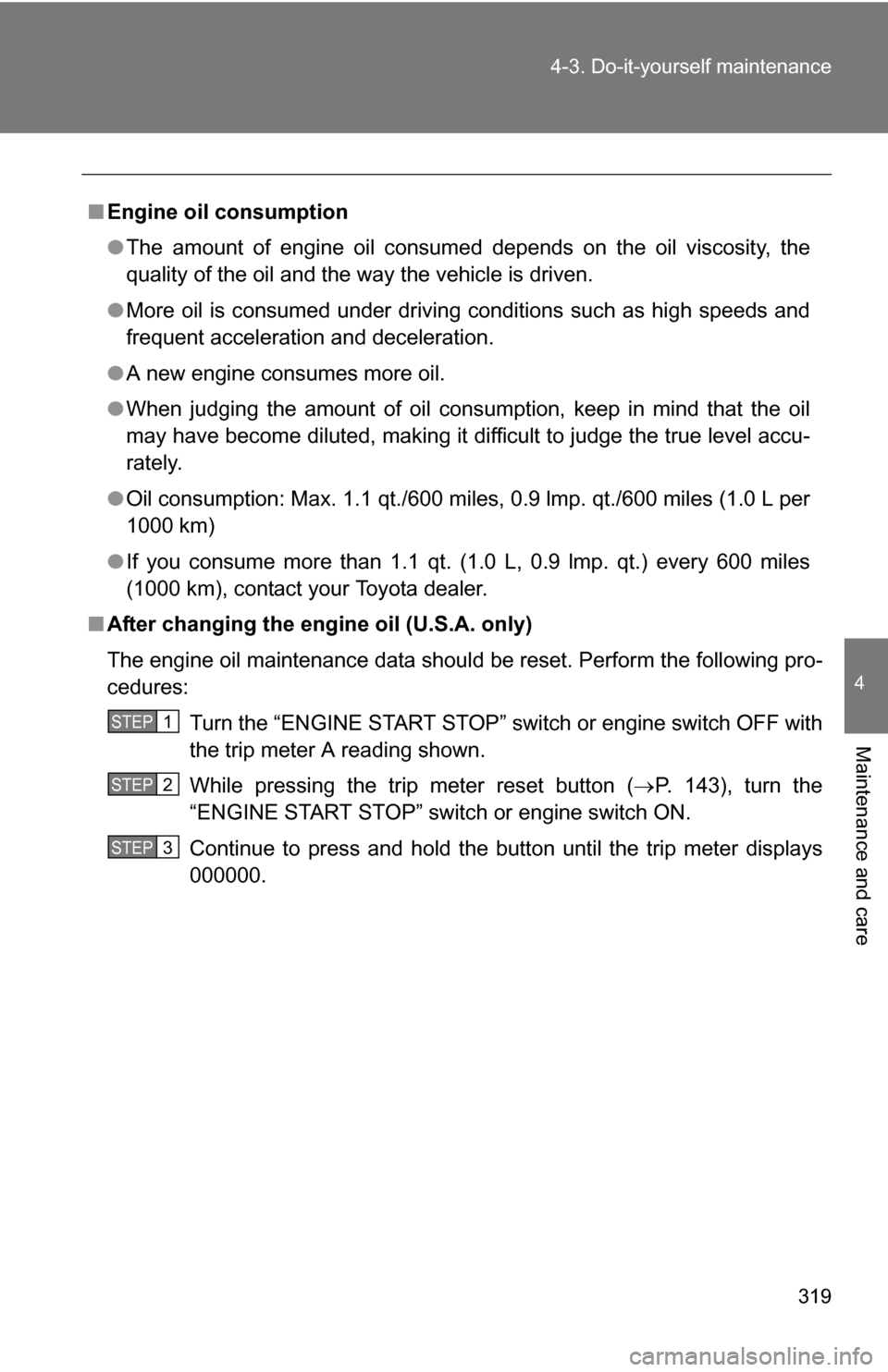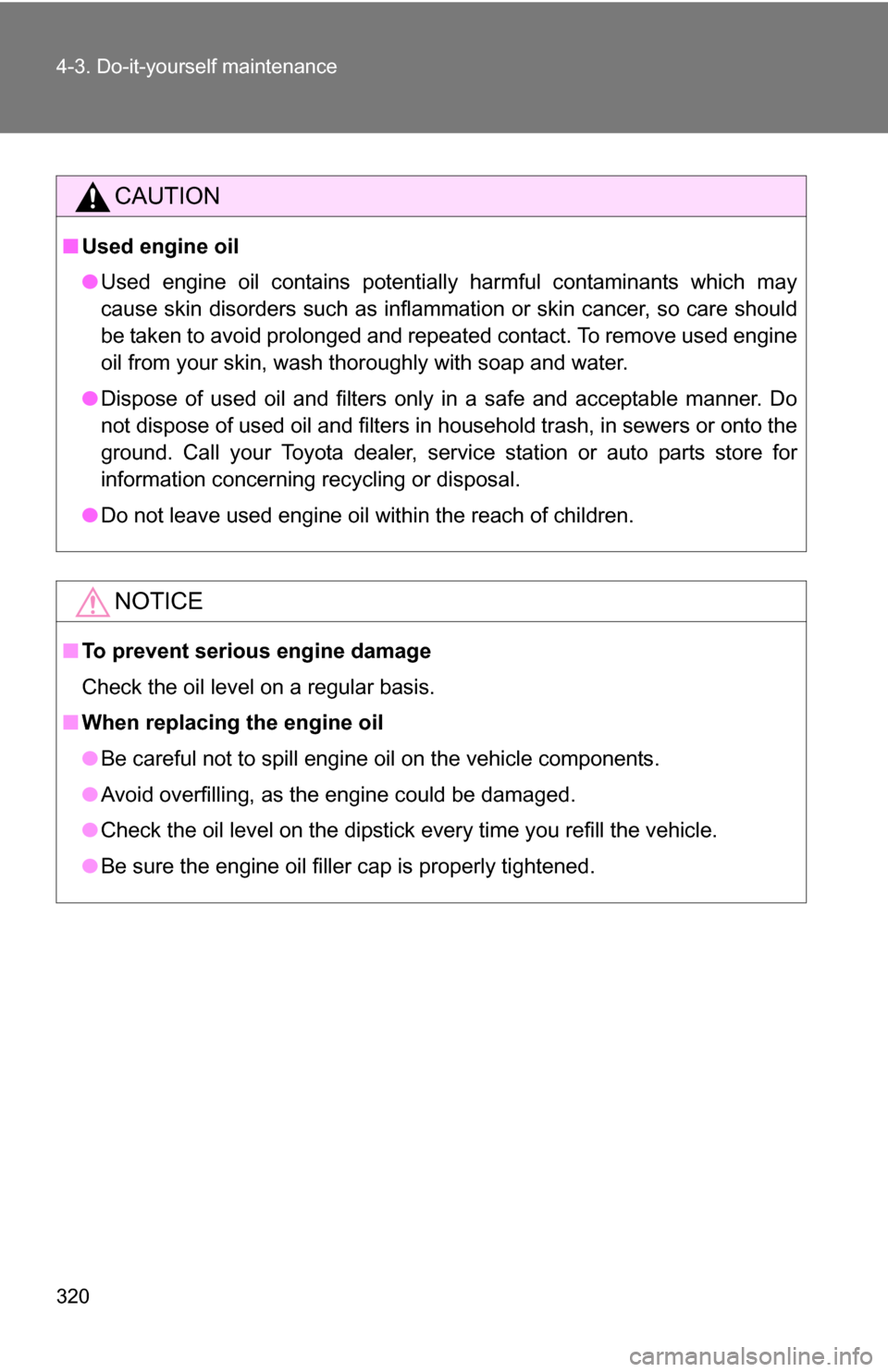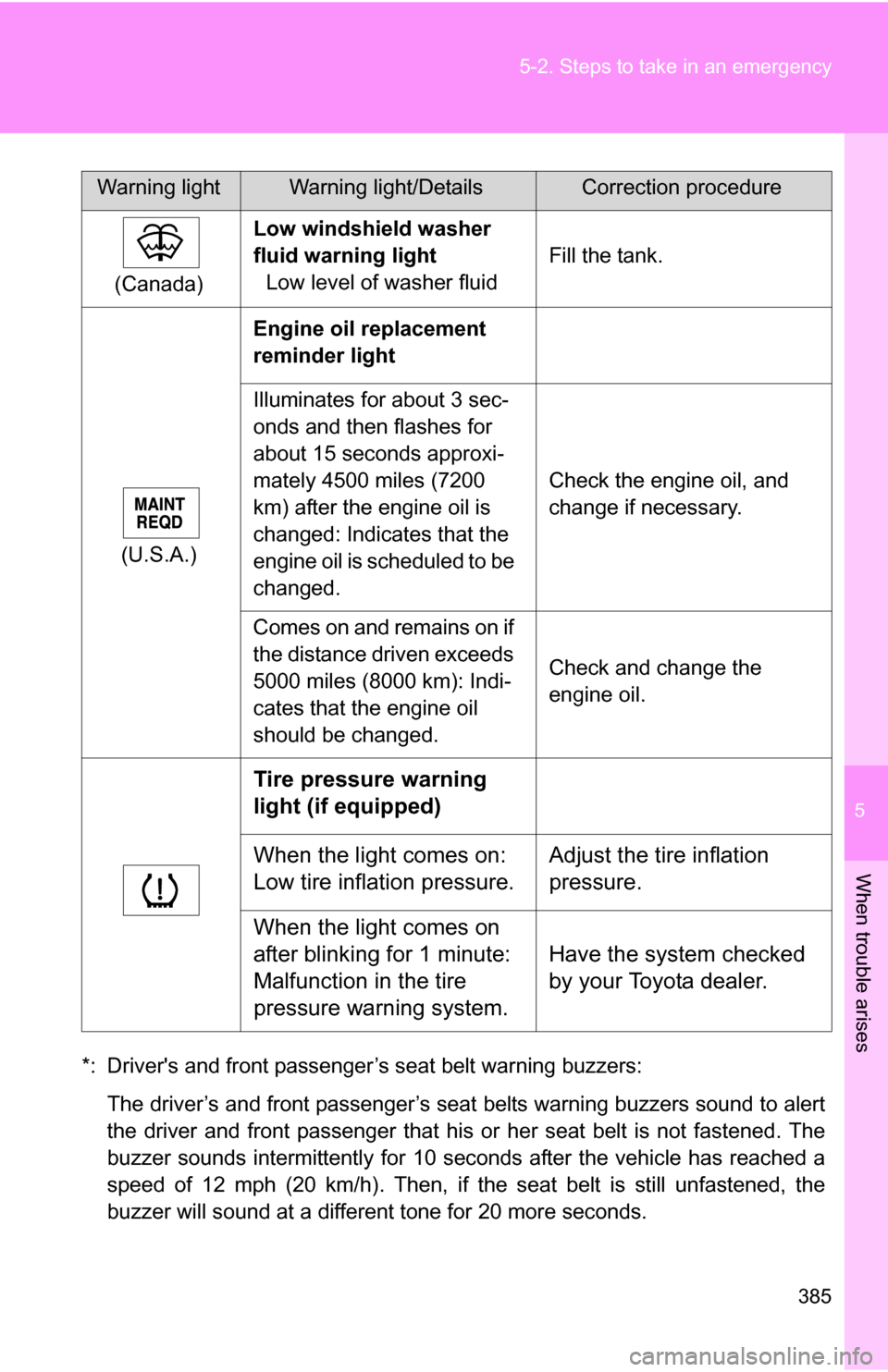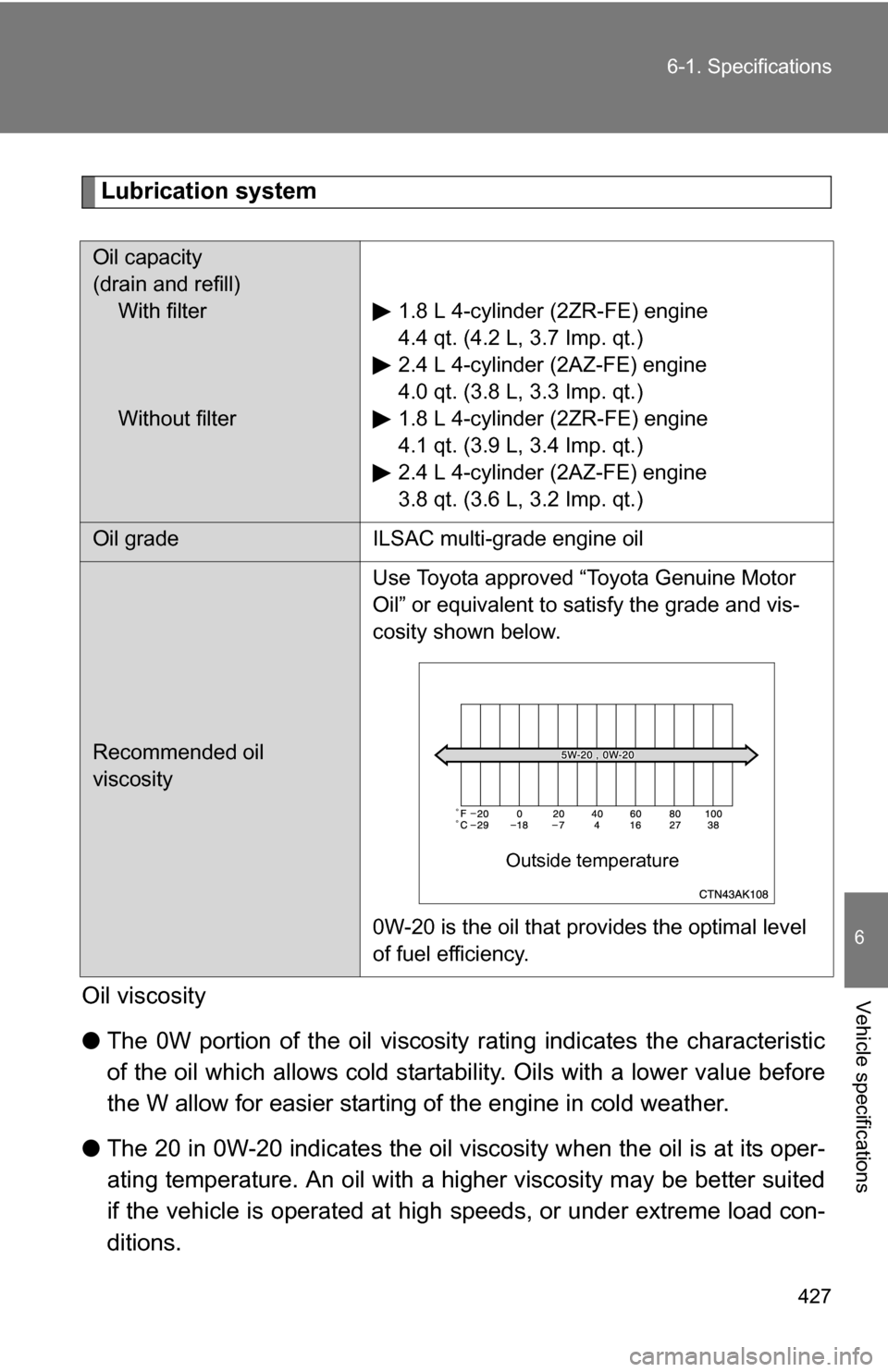Page 318 of 476
318 4-3. Do-it-yourself maintenance
Install the filler cap, turning it clockwise.
The approximate quantity of oil needed to raise the level between low and
full on the dipstick is indicated as follows:
1.8 L 4-cylinder (2ZR-FE) engine
1.6 qt. (1.5 L, 1.3 lmp. qt.)
2.4 L 4-cylinder (2AZ-FE) engine
1.1 qt. (1.0 L, 0.9 lmp. qt.)
■ Recommended viscosity
SAE 5W-20 or 0W-20 engine oil
may be used. However, SAE
0W-20 is the best choice for
good fuel economy and good
starting in cold weather.
■ How to read oil container labels
The ILSAC (International Lubricant Standardization and Approval
Committee) Certification Mark is added to some oil containers to
help you select th e oil you should use.
STEP 3
Outside temperature
Page 319 of 476

319
4-3. Do-it-yourself maintenance
4
Maintenance and care
■
Engine oil consumption
●The amount of engine oil consumed depends on the oil viscosity, the
quality of the oil and the way the vehicle is driven.
● More oil is consumed under driving conditions such as high speeds and
frequent acceleration and deceleration.
● A new engine consumes more oil.
● When judging the amount of oil consumption, keep in mind that the oil
may have become diluted, making it difficult to judge the true level accu-
rately.
● Oil consumption: Max. 1.1 qt./600 miles, 0.9 lmp. qt./600 miles (1.0 L per
1000 km)
● If you consume more than 1.1 qt. (1.0 L, 0.9 lmp. qt.) every 600 miles
(1000 km), contact your Toyota dealer.
■ After changing the engine oil (U.S.A. only)
The engine oil maintenance data should be reset. Perform the following pro-
cedures:
Turn the “ENGINE START STOP” switch or engine switch OFF with
the trip meter A reading shown.
While pressing the trip meter reset button ( P. 143), turn the
“ENGINE START STOP” switch or engine switch ON.
Continue to press and hold the button until the trip meter displays
000000.
STEP 1
STEP 2
STEP 3
Page 320 of 476

320 4-3. Do-it-yourself maintenance
CAUTION
■Used engine oil
●Used engine oil contains potentially harmful contaminants which may
cause skin disorders such as inflammation or skin cancer, so care should
be taken to avoid prolonged and repeated contact. To remove used engine
oil from your skin, wash thoroughly with soap and water.
● Dispose of used oil and filters only in a safe and acceptable manner. Do
not dispose of used oil and filters in household trash, in sewers or onto the
ground. Call your Toyota dealer, service station or auto parts store for
information concerning recycling or disposal.
● Do not leave used engine oil within the reach of children.
NOTICE
■To prevent serious engine damage
Check the oil level on a regular basis.
■ When replacing the engine oil
●Be careful not to spill engine oil on the vehicle components.
● Avoid overfilling, as the engine could be damaged.
● Check the oil level on the dipstick every time you refill the vehicle.
● Be sure the engine oil filler cap is properly tightened.
Page 385 of 476

5
When trouble arises
385
5-2. Steps to take in an emergency
*: Driver's and front passenger’s seat belt warning buzzers:
The driver’s and front passenger’s seat belts warning buzzers sound to alert
the driver and front passenger that his or her seat belt is not fastened. The
buzzer sounds intermittently for 10 seconds after the vehicle has reached a
speed of 12 mph (20 km/h). Then, if the seat belt is still unfastened, the
buzzer will sound at a different tone for 20 more seconds.(Canada)
Low windshield washer
fluid warning light
Low level of washer fluid Fill the tank.
(U.S.A.) Engine oil replacement
reminder light
Illuminates for about 3 sec-
onds and then flashes for
about 15 seconds approxi-
mately 4500 miles (7200
km) after the engine oil is
changed: Indicates that the
engine oil is scheduled to be
changed.
Check the engine oil, and
change if necessary.
Comes on and remains on if
the distance driven exceeds
5000 miles (8000 km): Indi-
cates that the engine oil
should be changed. Check and change the
engine oil.
Tire pressure warning
light (if equipped)
When the light comes on:
Low tire inflation pressure.
Adjust the tire inflation
pressure.
When the light comes on
after blinking for 1 minute:
Malfunction in the tire
pressure warning system. Have the system checked
by your Toyota dealer.
Warning lightWarning light/DetailsCorrection procedure
Page 386 of 476

386 5-2. Steps to take in an emergency
■Front passenger detect ion sensor and passenger seat belt reminder
● If luggage is placed on the front passenger seat, the front passenger
detection sensor may cause the warning light to flash, even if a passen-
ger is not sitting in the seat.
● If a cushion is placed on the seat, the sensor may not detect a passen-
ger, and the warning light may not operate properly.
■ Changing the engine oil (U.S.A. only)
Make sure to reset the oil change system. ( P. 319)
■
When the tire pressure warning light comes on
Check the tire inflation pressure and adjust to the appropriate level.
Pushing the tire pressure warning reset switch does not turn off the tire
pressure warning light.
■The tire pressure warning light ma y turn on due to natural causes
The tire pressure warning light may turn on due to natural causes such
as natural air leaks or tire inflation pressure changes caused by temper-
ature. In this case, adjusting the ti re inflation pressure will turn off the
warning light (after a few minutes).
Page 421 of 476
Vehicle specifications6
421
6-1. SpecificationsMaintenance data (fuel, oil level, etc.) ......... 422
Fuel information ............... 434
Tire information ................ 437
6-2. Customization Customizable features ..... 449
6-3. Initialization Items to initialize .............. 453
Page 422 of 476
422
6-1. Specifications
Maintenance data (fuel, oil level, etc.)
Dimensions and weights
*1: Unladen vehicles
*2: P195/65R15 tires
*3: P205/55R16 and P215/45R17 tires
Vehicle identification■ Vehicle identification number
The vehicle identificati on number (VIN) is the legal identifier for your
vehicle. This is the primary identification number for your Toyota. It is
used in registering the ownership of your vehicle.
This number is stamped on the
top left of the instrument panel.
Overall length 178.7 in. (4540 mm)
Overall width69.3 in. (1760 mm)
Overall height*157.7 in. (1465 mm)
Wheelbase102.4 in. (2600 mm)
Tread
Front60.2 in. (1530 mm)*2
59.8 in. (1520 mm)*3
Rear60.4 in. (1535 mm)*2
59.8 in. (1520 mm)*3
Vehicle capacity weight
(occupants + luggage) 825 lb. (370 kg)
Towing capacity
(trailer weight + cargo weight)1500 lb. (680 kg)
Page 427 of 476

427
6-1. Specifications
6
Vehicle specifications
Lubrication system
Oil viscosity
● The 0W portion of the oil viscosity rating indicates the characteristic
of the oil which allows cold startab ility. Oils with a lower value before
the W allow for easier starting of the engine in cold weather.
● The 20 in 0W-20 indicates the oil viscosity when the oil is at its oper-
ating temperature. An oil with a higher viscosity may be better suited
if the vehicle is operated at high speeds, or under extreme load con-
ditions.
Oil capacity
(drain and refill) With filter
Without filter 1.8 L 4-cylinder (2ZR-FE) engine
4.4 qt. (4.2 L, 3.7 Imp. qt.)
2.4 L 4-cylinder (2AZ-FE) engine
4.0 qt. (3.8 L, 3.3 Imp. qt.)
1.8 L 4-cylinder (2ZR-FE) engine
4.1 qt. (3.9 L, 3.4 Imp. qt.)
2.4 L 4-cylinder (2AZ-FE) engine
3.8 qt. (3.6 L, 3.2 Imp. qt.)
Oil grade
ILSAC multi-grade engine oil
Recommended oil
viscosity Use Toyota approved “Toyota Genuine Motor
Oil” or equivalent to satisfy the grade and vis-
cosity shown below.
0W-20 is the oil that provides the optimal level
of fuel efficiency.
Outside temperature